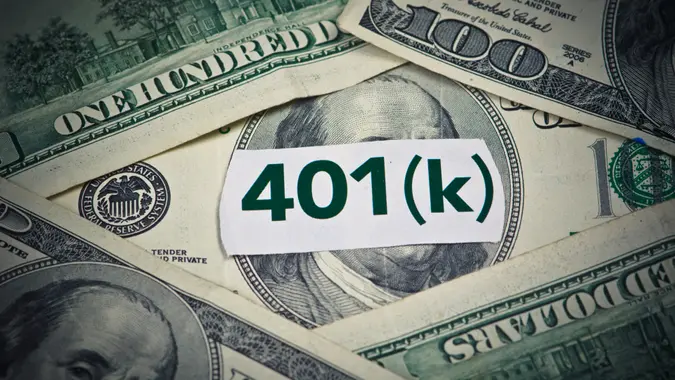Advertiser Disclosure
GOBankingRates works with many financial advertisers to showcase their products and services to our audiences. These brands compensate us to advertise their products in ads across our site. This compensation may impact how and where products appear on this site. We are not a comparison-tool and these offers do not represent all available deposit, investment, loan or credit products.
The 5 Most Important Changes to Your Retirement in Congress’s New ‘Secure 2.0’ Bills
 Written by
Josephine Nesbit
Written by
Josephine Nesbit

Commitment to Our Readers
GOBankingRates' editorial team is committed to bringing you unbiased reviews and information. We use data-driven methodologies to evaluate financial products and services - our reviews and ratings are not influenced by advertisers. You can read more about our editorial guidelines and our products and services review methodology.

20 YearsHelping You Live Richer

Reviewed by Experts

Trusted by Millions of Readers
Get ready for more changes to the U.S. retirement system. Congress is again aiming for the U.S. retirement system less than two years after signing the Secure Act into law. The House and Senate each have a bipartisan bill in the early stages of the legislative process, according to CNBC, and want to build upon the Secure Act to expand retirement security and encourage Americans to save.
The Securing a Strong Retirement Act, also known as Secure 2.0, has bipartisan support, and there will likely be action sooner rather than later, Timothy Lynch, senior director at the law firm of Morgan Lewis told CNBC. However, he noted that the bills would need to be worked out, especially when it comes to offsetting revenue losses, reports CNBC.
If this legislation becomes law, here is how retirement savers may be impacted.
Retirement and Student Loan Debt
Typically, employers can match retirement contributions up to a certain amount. Under the proposed legislation, employers can make matching contributions to workers’ retirement accounts based on workers’ own student loan payments. This would apply to 401(k) plans, 403(b) plans, SIMPLE IRAs and 457(b) plans, reports Kiplinger.
Catch-Up Contributions
Under current law, workers at age 50 can make catch-up contributions to their retirement accounts. For the current year, workers can contribute an extra $6,500 to 401(k) and 403(b) plans after reaching the $19,500 limit. For a SIMPLE IRA, they can add $3,000, noted Kiplinger.
Under the proposed bill, workers between the ages of 62 and 64 can contribute an extra $10,000 to 401(k) and 403(b) plans. Participants in a SIMPLE IRA could contribute an additional $5,000.
Additionally, Congress wants catch-up limits for workers 50 and older to be indexed for inflation beginning in 2023. According to Kiplinger, catch-up contribution amounts have been limited to $1,000 since 2006.
Required Minimum Distributions
The Secure Act changed when the required minimum distributions must begin from age 72 to 70 ½. Under the House bill, annual withdrawals wouldn’t have to start until age 73 in 2022, age 74 in 2029 and then age 75 by 2032, according to CNBC.
Meanwhile, the Senate bill would raise the age to 75 by 2032, waive RMDs for individuals with less than $100,000 in retirement savings and reduce the penalty for failing to take minimum distributions to 25% from 50%.
Annuity Contracts
Individuals can set up income streams later in life, called a qualified longevity annuity contract, or QLAC, reports CNBC. Currently, the maximum that can go into a QLAC is $135,000 or 25% of the value of your retirement accounts, whichever is less.
Both bills want to remove this cap and the Senate wishes to increase the maximum to $200,000. The bipartisan bills also call for the Treasury Department to create regulations to allow exchange-traded funds, or ETFs, to be investment options in variable annuity contracts.
Auto-Enrollment in Retirement Savings Plans
The House bill would require employers to automatically enroll workers in their 401(k) plan at a rate of at least 3% and then increase it each year until the worker is contributing 10% of their pay, reports CNBC. Smaller businesses with 10 employees or fewer or businesses under three years old would be excluded.
The Senate bill would not require auto-enrollment but it does include incentives to encourage companies to offer this feature.
More From GOBankingRates
Share this article:




You May Also Like

I Asked ChatGPT What To Do If I'm Retiring in 5 Years: Here's What It Said
December 04, 2025
4 min Read






90% of Americans Plan To Skip This Social Security Advice -- and It Could Cost Them
December 03, 2025
4 min Read

Here's What Retirees Wasted the Most Money On in 2025 -- and How To Avoid It in 2026
December 04, 2025
4 min Read

I Asked ChatGPT for Safe and Beautiful Retirement Spots for $1,500 a Month: These 5 Surprised Me
December 03, 2025
4 min Read

How the Retirement 'Spending Smile' Concept Can Help You Plan Your Future
December 03, 2025
4 min Read

Here's the Salary You Need To Make To Get the Maximum Social Security Benefit
December 03, 2025
4 min Read

I'm a Self-Made Millionaire: 5 Ways I'm Planning My Retirement -- Without a 401(k)
December 03, 2025
4 min Read


Here's How Trump's $2K Dividend Could Impact Retirees on Social Security
December 03, 2025
4 min Read

- How Long Will My Money Last?
- How Much Do You Need To Retire?
- How To Prepare For Retirement
- How To Save For Retirement Without A 401K
Learn More About Early Retirement Planning
Make your money work for you
Get the latest news on investing, money, and more with our free newsletter.
By subscribing, you agree to our Terms of Use and Privacy Policy. Unsubscribe at any time.


Thanks!
You're now subscribed to our newsletter.
Check your inbox for more details.



Sending you timely financial stories that you can bank on.
Sign up for our daily newsletter for the latest financial news and trending topics.
For our full Privacy Policy, click here.
Looks like you're using an adblocker
Please disable your adblocker to enjoy the optimal web experience and access the quality content you appreciate from GOBankingRates.
- AdBlock / uBlock / Brave
- Click the ad blocker extension icon to the right of the address bar
- Disable on this site
- Refresh the page
- Firefox / Edge / DuckDuckGo
- Click on the icon to the left of the address bar
- Disable Tracking Protection
- Refresh the page
- Ghostery
- Click the blue ghost icon to the right of the address bar
- Disable Ad-Blocking, Anti-Tracking, and Never-Consent
- Refresh the page



